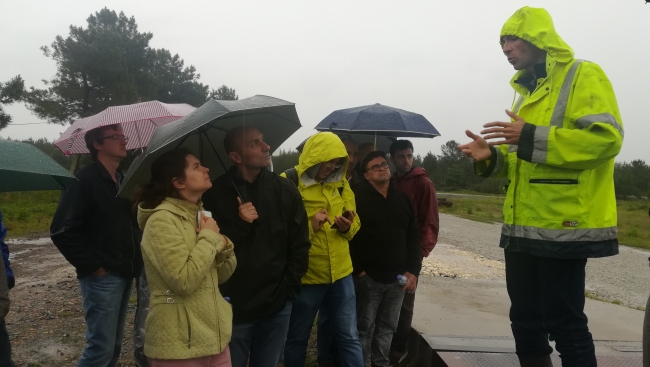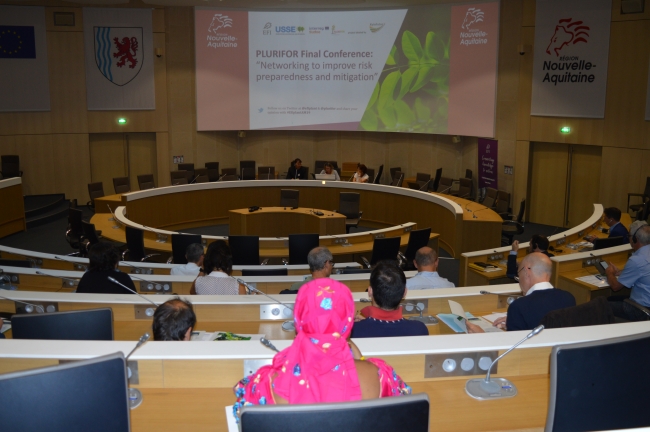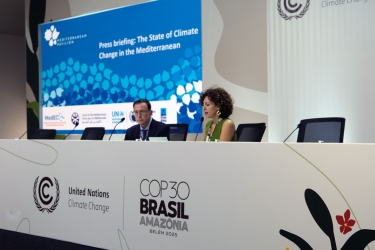Joint EFIPLANT & IEFC Annual Meeting 2019: Facilitating international cooperation between scientists and with stakeholders on planted forest issues

The Joint EFIPLANT & IEFC Annual Meeting 2019 took place on 3-5 June 2019 in the INRA premises of Pierroton (France). About 40 people, mostly, EFIPLANT networks members participated to the meeting. The two-day event- also included the Final Conference of the PLURIFOR, a European funded project that has been a successful example of cross-border cooperation considering that forest hazards are a common threat to south-west European forests and they do not have administrative limits.
Planted Forest Facility: Past, present and future
As in previous editions, the technical annual meeting, jointly organised with IEFC, took place on the first day.
The morning was dedicated to an open session where all partners of the network were invited to present results, ongoing projects and activities related to planted forest:adaptation to climate change, plantation performance assessment, fire risk mitigations, defoliation impacts (these topics/presentations can be consulted below). Also, the president of IEFC Nick McCarthy rewarded Antonio Correia with the 1st prize “IEFC Young Researcher on Planted Forests 2019” for his remarkable work done for the REINFFORCE project modelling survival and growth response of 35 species in the Atlantic sea.
The afternoon session meeting was opened by Robert Mavsar, EFI deputy-director, with a presentation on the current status and future perspectives of the Planted Forest Facility. Christophe Orazio, the director of the EFIPLANT Facility, gave a detailed presentation of the Facility as well as its on-going activities (including projects on intensification, risk management and bio economy related to planted forest) and major outputs during the year. Communication, dissemination and capacity building activities were also reported, demonstrating the capacity of the Unit to facilitate international cooperation between scientists and with stakeholders on a large set of topics related to the planted forest.
The afternoon session ended with the IEFC General Assembly making a space about the consultation of participants on the strength and weaknesses of ongoing work on planted forest and validating the plan to host a research network on planted forest that would substitute the current Planted Forest Facility.
Presentations of the day below:
- Cudjoe, Eric : Modelling for the Adaptation of Forest Ecosystems and Forestry to Climate Change
- Collet, Catherine : Assessing multiple performances of plantation silviculture in the early stages
- Barreiro, Susana : Using Simulation tools to improve plantations' management and mitigate fire risk in Portugal
- Rua, João : Cost-benefit analysis of defoliation scenarios using a 3-PG adaptation
- Correira, Antonio: Assessing Forest Species tolerance and associated risk for growth and survival in arboreta along Atlantic climate gradient
- Orazio, Christophe: EFIPLANT report on current and future activities
- Mc Carthy, Nick :IEFC Strategic Plan 2019-2023
- Mavsar,Robert : Future of the Planted Forests Facility
The following day, attended by over 60 people, was dedicated to the PLURIFOR project final conference. This project was involving many of the IEFC partners and focused on design and improvement of transboundary forest risk management plans (consult the report of this event here)
PLURIFOR: cross-border collaboration to improve risk preparedness and mitigation in planted forests
PLURIFOR end meeting took place on Tuesday 5th of June at the Nouvelle Aquitaine Regional Council in Bordeaux (France).
Mrs Béatrice Gendreau (Forest delegate at the Nouvelle-Aquitaine regional council) and Christophe Orazio (EFIPLANT) opened the meeting. With a forest and wood industry representing 56,000 jobs in and a turnover above 10 billion euros, Mrs Gendreau highlighted the importance of an efficient management of forest risks in Nouvelle-Aquitaine. “The conservation of our forests is crucial. That's why we have supported for many years the work developed by EFIPLANT and, in particular, by the PLURIFOR project”.
This 3-year project, briefly presented by Mr. Orazio during the meeting and funded by European Union SUDOE Interreg, focused on the development of regional and transnational risk management plans for forest areas that are susceptible to biotic and abiotic hazards. Eleven partners and twenty-one associate partners from France, Spain and Portugal took place in the project which focused on the risks posed by 8 forest hazards: storms, fire, soil degradation, pinewood nematode (Bursaphelenchus xylophilus), chestnut gall wasp (Dryocosmus kuriphilus), Eucalyptus weevil (Gonipterus scutellatus), Fusarium circinatum, and emerging pests and pathogens. Each risk leader presented a summary of the main tools and risk management plans obtained during the project. These outcomes will serve forest authorities as well as forest stakeholders concerned by risk management (presentations available on the project’s website). For example, Barry Gardiner (EFIPLANT) presented how the storm risk had been assessed making vulnerability maps in Nouvelle-Aquitaine and Euskadi (Spain) to better support and improve prevention at a regional scale.
The 13 plans and 27 tools developed by the project are freely accessible on the project webpage. They include risk mapping tools, early detection method, diagnostic systems, and Silvalert app, a citizen participation tool for forest tree damages reporting.
Testimonials from forest stakeholders on the project
The strong impact of the project is mainly due to the work of consulting stakeholders and transfer actions through risk management plans and targeted training. Six forest stakeholders presented their view on the main contributions of the project to their current management methods of forest hazards.
Emmanuel Kersaudy (DRAAF) stated that up-to-date scientific studies on forest risk management were useful as evidence information when exchanging with national and European forest authorities. He insisted on the importance of having forest risk solutions that can be applied at an operational level regionally and nationally and called for further collaboration and international exchanges. Likewise, Patrick Lacombe (DRAAF) informed the public that the EFI team would also be providing critical height and wind maps to locate high storm risk stands that will be the corner stones of many actions mentioned in the plans. Gaëlle Burlot (Caisse Phytosanitaire) analysed how PLURIFOR output products could be applied in the Nouvelle Aquitaine region. She advised the project leaders to further liaise with forest owners when developing forest risk management tools. Also, Carlos Uriagereka (Provincial Council of Bizkaia) stated that PLURIFOR was successful in providing more data on risk prevention and facilitating communication with other forest institutions. And, to conclude, Pablo Arbones Maciñeira (Seaga) emphasized the importance of synergies between public and private actors, the need for skilled teams and a flexible organization.
SILVALERT phone app: An innovative tool for individual citizens
One of the project output celebrated by the attendees was the innovative aspect of citizen participation achieved through the SILVALERT phone app. Ander Arias (NEIKER Tecnalia) stated that: “Thanks to PLURIFOR we have developed a tool as useful as Silvalert, a mobile app that allows us to measure the level of soil disturbance and take appropriate measures”. Other stakeholders such as Conceiçao Silva (UNAC) expressed an interest to further develop the use of Silvalert application in Portugal. (More info about the presentations here).
PLURIFOR: A multi-risk approached that allows synergies between different risks
The third day consisted in a field trip in the morning and the 3rd management council in the afternoon.
The fieldtrip included 3 subsequent visits around Le Barp – Cestas sector. Twenty-two people participated to the visits and learned how storm, fire and biotic hazards were locally managed. The participants first visited an empty wood storage area managed by a forestry cooperative, Alliance Forêt Bois. They also visited a water tanker installed in the forest that store water in case of an event of fire and manage by the network of DFCI associations in France as all the fire infrastructures. At a last stop, the participants visited an insect trapping system located close to an industrial area for an early monitoring of invasive insects and fungi done by French forest health service.

Read more about the PLURIFOR Final Conferece here
Read more about previous EFIPLANT Annual meetings here
Photos by Marta Briones, EFIPLANT
Pictures here







